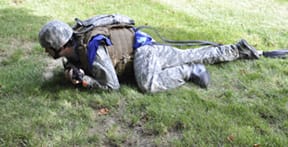Article: Military Technology

Wearing body armour for protection against bullets and shrapnel has been a double-edged sword for soldiers. While the armour provides an indispensable defence, its weight and placement on the body exposes the wearer to neck, shoulder and back discomfort, and possibly years of lingering pain. The problem is not just the armour, but also the heavy equipment that soldiers routinely wear for hours and days at a time that can weigh more than 60 lbs — including rifles, ammunition, grenades, radios, medial kits, backpacks, water and other supplies. To alleviate discomfort and reduce the fatigue that reduces the soldier’s tactical effectiveness, a new generation of body armour systems is being developed. A body mapping pressure system by Sensor Products Inc. called Tactilus® is enabling a highly-skilled team of designers and engineers to develop new vests and carriage systems that optimally distribute the load that soldiers carry. The project is being directed by KDH Defense Systems of Johnstown, PA through a contract with the US Air Force.
EDGE Product Development of Newtown, PA is using human factors engineering, design and prototyping to adapt the armour systems to the needs of the soldiers. “To enable soldiers to perform their duties with more comfort and less fatigue, we are designing body armour systems that eliminate ‘hot spots’ of excessive pressure during typical activities,” says Daniel Massam, director of industrial design.
When a soldier complains that they feel pressure in a certain area, the pressure points change on the computer screen and pinpoint where the vest and armor need to be redesigned to improve the pressure distribution. Besides increasing comfort, the team says the new body armor will significantly increase the soldier’s flexibility and maneuverability, which has enormous strategic advantages in the field.
Pushed to their creative limits, participants in the project are breaking new ground. Jason Blume, an engineer at Sensor Products, discovered new uses for their Tactilus® electronic sensor system when he suggested the sensors could work in a new configuration to fit the size and shape of the vest and carriage.



